Volatilität, Wachstum und Finanzkrisen
Diese Forschungsgruppe analysiert die Entstehung von Instabilitäten im Finanzsystem und die realökonomischen Konsequenzen von Finanzkrisen. Dabei werden kausale Reaktionen gesamtwirtschaftlicher Größen auf makroökonomische Schocks identifiziert. Frühwarnmodelle beschreiben das zyklische Auftreten von Vulnerabilitäten im Finanzsystem.
IWH-Datenprojekt: Financial Stability Indicators in Europe
Forschungscluster
Finanzresilienz und RegulierungIhr Kontakt

- Abteilung Makroökonomik
PROJEKTE
01.2022 ‐ 12.2023
Sovereign Risk Shocks
Deutsche Bundesbank
05.2017 ‐ 09.2019
Frühwarnmodelle für systemische Bankenkrisen: Der Effekt von Modell- und Schätzunsicherheit
Deutsche Forschungsgemeinschaft (DFG)
01.2018 ‐ 12.2018
International Monetary Policy Transmission
Deutsche Bundesbank
Referierte Publikationen

Extreme Risks in Financial Markets and Monetary Policies of the Euro-candidates
in: Comparative Economic Studies, Nr. 4, 2011
Abstract
This study investigates extreme tail risks in financial markets of the euro-candidate countries and their implications for monetary policies. Our empirical tests show the prevalence of extreme risks in the conditional volatility series of selected financial variables, that is, interbank rates, equity market indexes and exchange rates. We argue that excessive instability of key target and instrument variables should be mitigated by monetary policies. Central banks in these countries will be well-advised to use both standard and unorthodox (discretionary) tools of monetary policy while steering their economies out of the financial crisis and through the euro-convergence process.

Central and Eastern European Countries in the Global Financial Crisis: A Typical Twin Crisis?
in: Post-Communist Economies, Nr. 4, 2011
Abstract
This paper shows that during the Great Recession, banking and currency crises occurred simultaneously in Central and Eastern Europe. Events, however, differed widely from what happened during the Asian crisis that usually serves as the model case for the concept of twin crises. We look at three elements that help explaining the nature of events in Central and Eastern Europe: the problem of currency mismatches, the relation between currency and banking crises, and the importance of multinational banks for financial stability. It is shown that theoretical considerations concerning internal capital markets of multinational banks help understand what happened on capital markets and in the financial sector of the region. We discuss opposing effects of multinational banking on financial stability and find that institutional differences are the key to understand differing effects of the global financial crisis. In particular, we argue that it matters if international activities are organized by subsidiaries or by cross-border financial services, how large the share of foreign currency-denominated credit is and whether the exchange rate is fixed or flexible. Based on these three criteria we give an explanation why the pattern of the crisis in the Baltic States differed markedly from that in Poland and the Czech Republic, the two largest countries of the region.
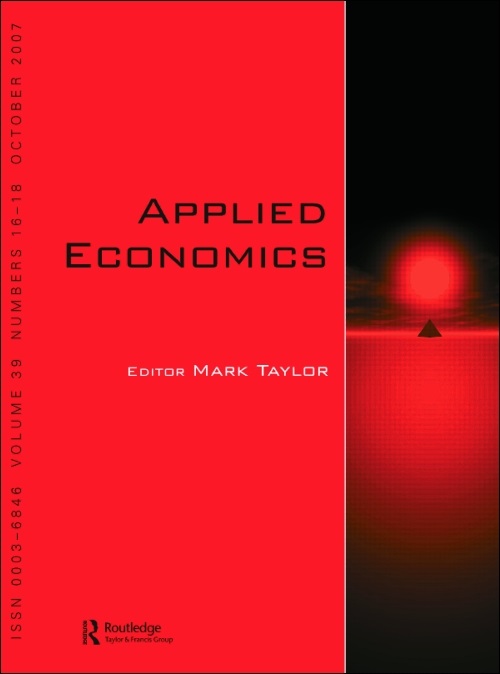
Inflation and Relative Price Variability in the Euro Area: Evidence from a Panel Threshold Model
in: Applied Economics, Nr. 4, 2012
Abstract
The impact of inflation on Relative Price Variability (RPV) generates an important channel for real effects of inflation. This article provides first evidence on the empirical relation between inflation and RPV in the euro area. Stirred by the widespread use of inflation caps or target bands in monetary policy practice, we are particularly interested in threshold effects of inflation. In line with the predictions of monetary search models, our results indicate that expected inflation significantly increases RPV only if inflation is either very low (below 0.95% per annum (p.a.)) or very high (above 4.96% p.a.).

Interest Rate Convergence in the Euro-Candidate Countries: Volatility Dynamics of Sovereign Bond Yields
in: Emerging Markets Finance and Trade, 2010
Abstract
We argue that a “static“ specification of the Maastricht criterion for long-term bond yields is not conducive to assessing stability of financial systems in euro-candidate countries. Instead, we advocate a dynamic approach to assessing interest rate convergence to a common currency that is based on the analysis of financial system stability. Accordingly, we empirically test volatility dynamics of the ten-year sovereign bond yields of the 2004 EU accession countries in relation to the eurozone yields during the January 2, 2001-January 22, 2009, sample period. Our results show a varied degree of the relationship between domestic and eurozone sovereign bond yields, the most pronounced for the Czech Republic, Slovenia, and Poland, and weaker for Hungary and Slovakia. We find some divergence of relative bond yields since the EU accession.

A Cost Efficient International Lender of Last Resort
in: International Research Journal of Finance and Economics, 2010
Abstract
The current reform of the International Monetary Fund’s (IMF) lending instruments has transformed the Fund towards an international lender of last resort (ILOLR). Current research discusses various general frameworks for installing an ILOLR. However, it remains unclear how the ILOLR should actually operate. This paper discusses six different options for the construction of an ILOLR that supports central banks during currency crises. The paper concludes that the most cost efficient version of the ILOLR would be direct intervention by the IMF using IMF resources, with the option of using additional reserves from central banks. The paper considers measures of cost efficiency, such as cost of borrowing, intervention, and sterilization and moral hazard problems.
Arbeitspapiere
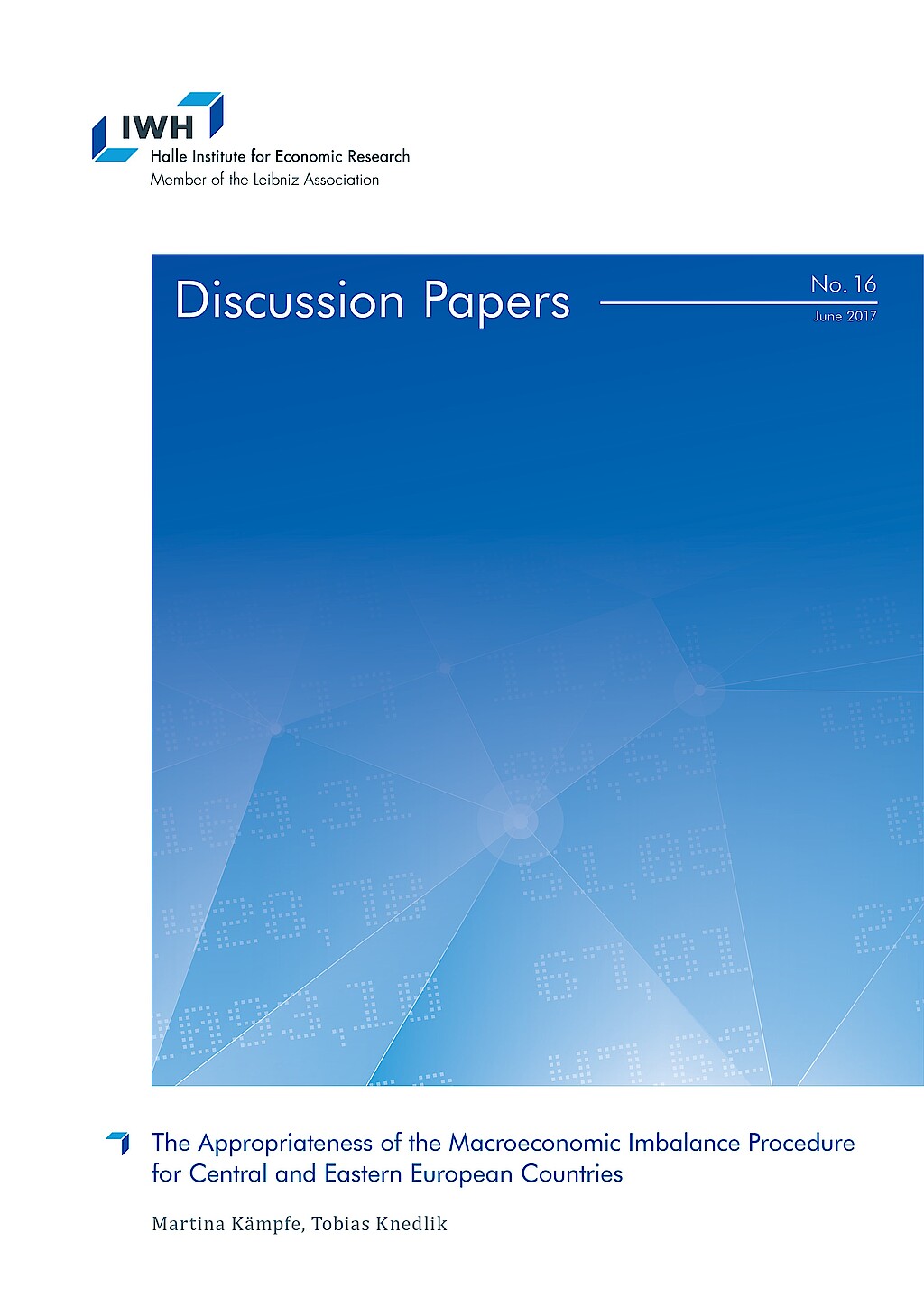
The Appropriateness of the Macroeconomic Imbalance Procedure for Central and Eastern European Countries
in: IWH Discussion Papers, Nr. 16, 2017
Abstract
The experience of Central and Eastern European countries (CEEC) during the global financial crisis and in the resulting European debt crises has been largely different from that of other European countries. This paper looks at the specifics of the CEEC in recent history and focuses in particular on the appropriateness of the Macroeconomic Imbalances Procedure for this group of countries. In doing so, the macroeconomic situation in the CEEC is highlighted and macroeconomic problems faced by these countries are extracted. The findings are compared to the results of the Macroeconomic Imbalances Procedure of the European Commission. It is shown that while the Macroeconomic Imbalances Procedure correctly identifies some of the problems, it understates or overstates other problems. This is due to the specific construction of the broadened surveillance procedure, which largely disregarded the specifics of catching-up economies.
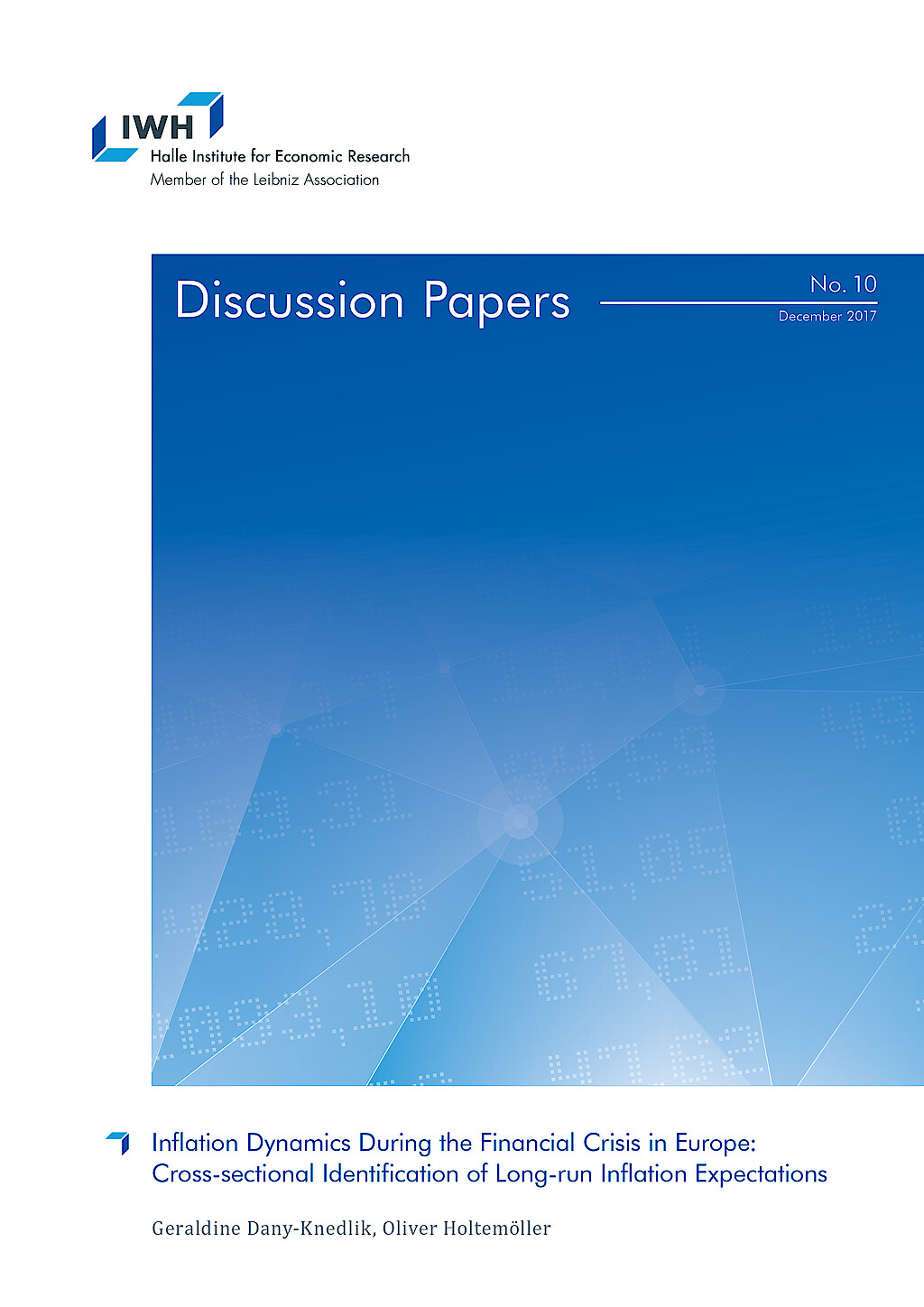
Inflation Dynamics During the Financial Crisis in Europe: Cross-sectional Identification of Long-run Inflation Expectations
in: IWH Discussion Papers, Nr. 10, 2017
Abstract
We investigate drivers of Euro area inflation dynamics using a panel of regional Phillips curves and identify long-run inflation expectations by exploiting the crosssectional dimension of the data. Our approach simultaneously allows for the inclusion of country-specific inflation and unemployment-gaps, as well as time-varying parameters. Our preferred panel specification outperforms various aggregate, uni- and multivariate unobserved component models in terms of forecast accuracy. We find that declining long-run trend inflation expectations and rising inflation persistence indicate an altered risk of inflation expectations de-anchoring. Lower trend inflation, and persistently negative unemployment-gaps, a slightly increasing Phillips curve slope and the downward pressure of low oil prices mainly explain the low inflation rate during the recent years.
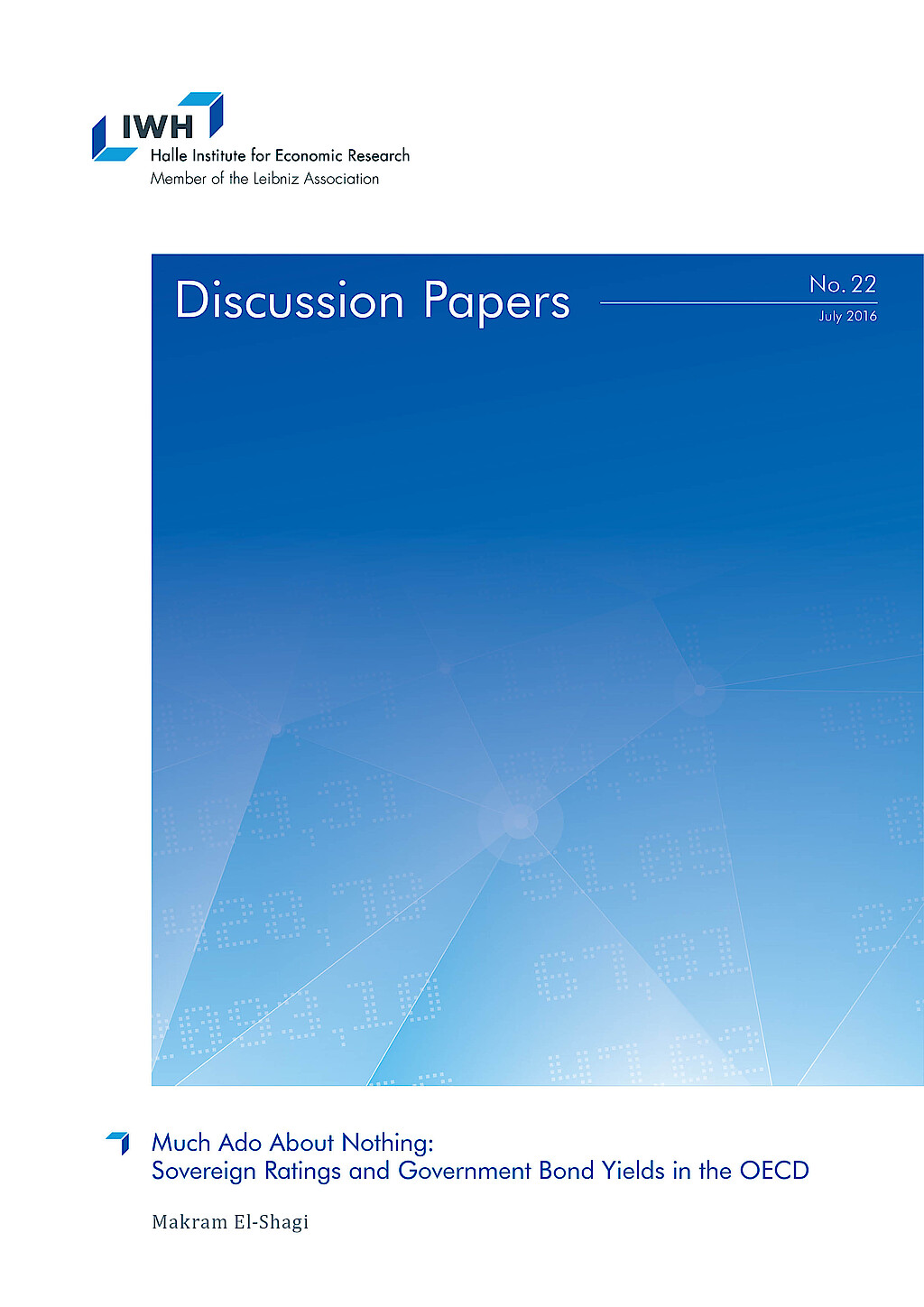
Much Ado About Nothing: Sovereign Ratings and Government Bond Yields in the OECD
in: IWH Discussion Papers, Nr. 22, 2016
Abstract
In this paper, we propose a new method to assess the impact of sovereign ratings on sovereign bond yields. We estimate the impulse response of the interest rate, following a change in the rating. Since ratings are ordinal and moreover extremely persistent, it proves difficult to estimate those impulse response functions using a VAR modeling ratings, yields and other macroeconomic indicators. However, given the highly stochastic nature of the precise timing of ratings, we can treat most rating adjustments as shocks. We thus no longer rely on a VAR for shock identification, making the estimation of the corresponding IRFs well suited for so called local projections – that is estimating impulse response functions through a series of separate direct forecasts over different horizons. Yet, the rare occurrence of ratings makes impulse response functions estimated through that procedure highly sensitive to individual observations, resulting in implausibly volatile impulse responses. We propose an augmentation to restrict jointly estimated local projections in a way that produces economically plausible impulse response functions.
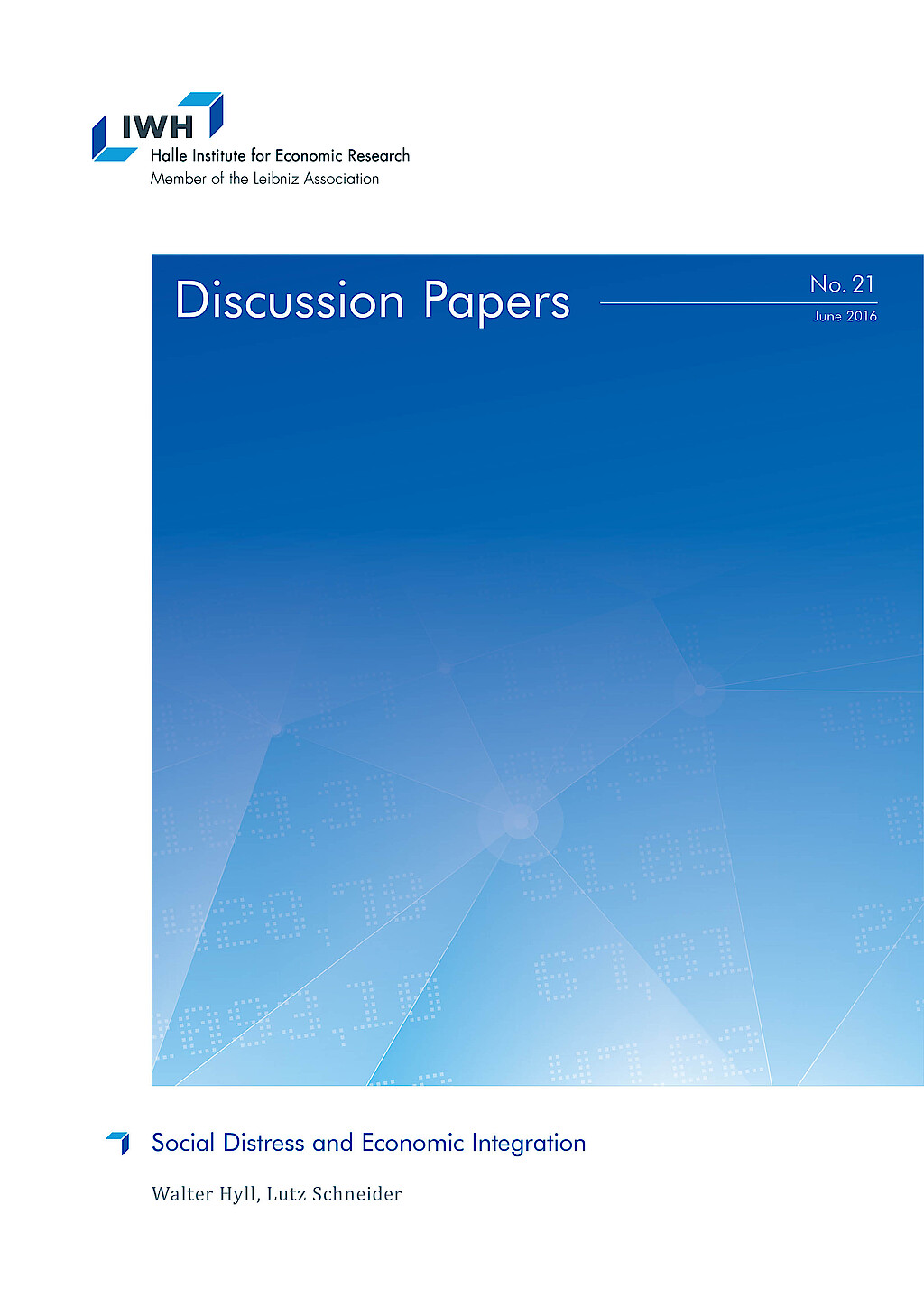
Exit Expectations and Debt Crises in Currency Unions
in: IWH Discussion Papers, Nr. 18, 2015
Abstract
Membership in a currency union is not irreversible. Exit expectations may emerge during sovereign debt crises, because exit allows countries to reduce their liabilities through a currency redenomination. As market participants anticipate this possibility, sovereign debt crises intensify. We establish this formally within a small open economy model of changing policy regimes. The model permits explosive dynamics of debt and sovereign yields inside currency unions and allows us to distinguish between exit expectations and those of an outright default. By estimating the model on Greek data, we quantify the contribution of exit expectations to the crisis dynamics during 2009 to 2012.

Flight Patterns and Yields of European Government Bonds
in: IWH Discussion Papers, Nr. 10, 2013
Abstract
The current European Debt Crisis has led to a reinforced effort to identify the sources of risk and their influence on yields of European Government Bonds. Until now, the potentially nonlinear influence and the theoretical need for interactions reflecting flight-to-quality and flight-to-liquidity has been widely disregarded. I estimate government bond yields of the Euro-12 countries without Luxembourg from May 2003 until December 2011. Using penalized spline regression, I find that the effect of most explanatory variables is highly nonlinear. These nonlinearities, together with flight patterns of flight-to-quality and flight-to-liquidity, can explain the co-movement of bond yields until September 2008 and the huge amount of differentiation during the financial and the European debt crisis without the unnecessary assumption of a structural break. The main effects are credit risk and flight-to-liquidity, while the evidence for the existence of flight-to-quality and liquidity risk (the latter measured by the bid-ask spread and total turnover of bonds) is comparably weak.














